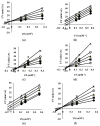Anti-Helicobacter pylori and urease inhibition activities of some traditional medicinal plants
- PMID: 23434867
- PMCID: PMC6270356
- DOI: 10.3390/molecules18022135
Anti-Helicobacter pylori and urease inhibition activities of some traditional medicinal plants
Abstract
Different parts of Acacia nilotica (L.) Delile, Calotropis procera (Aiton) W.T. Aiton, Adhatoda vasica Nees, Fagoniaar abica L. and Casuarina equisetifolia L. are traditionally used in folk medicine for the treatment of a variety of common ailments like nausea, cold, cough, asthma, fevers, diarrhea, sore throat, swelling, etc. The present study was aimed to evaluate the anti-Helicobacter pylori and urease inhibition activities of extracts produced from the above selected medicinal plants native to Soon Valley (home to an old civilization) in the Punjab province of Pakistan. Methanol, acetone and water extracts of the plants were evaluated for anti-bacterial activity against thirty four clinical isolates and two reference strains of H. pylori. Minimum inhibitory concentrations (MICs) of the extracts were determined using the agar dilution method and compared with some standard antibiotics like amoxicillin (AMX), clarithromycin (CLA), tetracycline (TET) and metronidazole (MNZ), used in the triple therapy for H. pylori eradication. H. pylori urease inhibition activity of the extracts was assessed by the phenol red method, wherein, Lineweaver-Burk plots were used to determine Michaelis-Menten constants for elucidating the mechanism of inhibition. Methanol and acetone extracts from Acacia nilotica and Calotropis procera exhibited stronger anti-H. pylori activity than MNZ, almost comparable activity with TET, but were found to be less potent than AMX and CLT. The rest of the extracts exhibited lower activity than the standard antibiotics used in this study. In the H. pylori urease inhibitory assay, methanol and acetone extracts of Acacia nilotica and Calotropis procera showed significant inhibition. Lineweaver-Burk plots indicated a competitive mechanism for extract of Acacia nilotica, whereas extract of Calotropis procera exhibited a mixed type of inhibition.
Figures


References
-
- Amin M., Iqbal M.S., Hughes R.W., Khan S.A., Reynolds P.A., Enne V.I., Rahman S., Mirza A.S. Mechanochemical synthesis and in vitro anti-Helicobacter pylori and urease inhibitory activities of novel zinc(II)-famotidine complex. J. Enzyme Inhib. Med. Chem. 2010;25:383–3890. - PubMed
MeSH terms
Substances
LinkOut - more resources
Full Text Sources
Other Literature Sources
Medical

